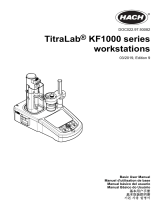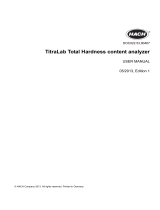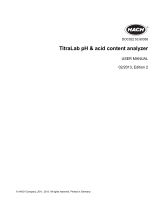
Get a sample measurement
Use this option to get sample measurements with one of the installed applications.
1. From the main menu, select the measurement application, then push Start. Application
information shows on the display.
2. Read the related "Application Note" from the USB applications key for more instructions.
3. If necessary, select an icon for more information or to change some data.
4. Fill a beaker with the recommended sample amount that shows on the display. If necessary, add
sufficient deionized water to make sure the sensor is correctly installed in the sample.
5. Carefully put a magnetic stir bar into the beaker. Make sure there is no liquid spill.
6. Attach the beaker to the sensor holder.
7. Make sure that the icon at the bottom of the display is highlighted. Do the instructions that
show on the display adjacent to this icon. Refer to Connect the sensor on page 13 to make sure
that the tubes and sensor are correctly aligned.
8. Push Start to start the measurement. Measurement data shows on the display.
9. If the default stirring speed needs to be adjusted, push the up and down arrow keys to increase or
decrease the speed.
10. If the options are available during the measurement procedure, push Skip to ignore the current
step or push Stop to abort the measurement.
11. When the measurement is complete, push the arrow keys to see the different measurement
views.
12. Push Next for the options that follow:
Option Description
Replicate
sample
Use this option to start the same titration on the same sample. This is used to study the
repeatability by successively analyzing several parts of the same sample. At the end of
each measurement, a window shows the average value, the standard deviation and the
relative standard deviation.
New sample Use this option to start the same titration on a new sample. No standard deviation or
relative standard deviation measurements will be done.
13. Push Exit to go back to the main menu.
Manage the data log
To select data to view, delete or export, specify data filters
1. From the main menu, select Data log.
2. Select an option, then push Select.
Option Description
View data log Views measurement data. Select individual lines of data to view more content.
Export data log Exports measurement data from the system to an external device. Preview data selection
before it is exported. Make sure that an external device is connected to the instrument
(e.g., a USB key, external hard drive, etc.).
Delete data log Removes measurement data from the system. Previews data selection before it is
removed.
3. Specify the data extraction parameters. Push the left and right arrow keys to make a selection.
Push the up and down arrow keys to select an option.
Option Description
Result type Sets the type of result available.
18 English


























